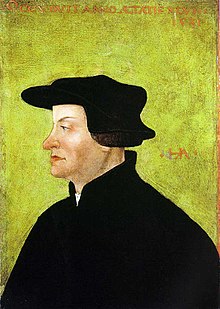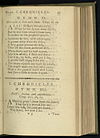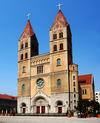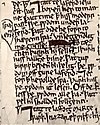Portal:Christianity/Selected article/2010
January 2010
The
The Commandments appear in the earliest Church writings; the Catechism states that they have "occupied a predominant place" in teaching the faith since the time of Saint
February 2010
Church teaching of the Commandments is largely based on the Old and
March 2010
.
(more)April 2010

The principal sources of information regarding Jesus' life and teachings are the four
though some scholars argue such texts as the Gospel of Thomas and the Gospel of the Hebrews [6][7] are also relevant.[8]Most critical scholars in biblical studies believe that some parts of the New Testament are useful for reconstructing Jesus' life,[9][10][11][12] agreeing that Jesus was a
Christians predominantly believe that Jesus is the "
May 2010
June 2010
July 2010

Huldrych (or Ulrich
In 1519, Zwingli became the pastor of the
August 2010

"Amazing Grace" is a Christian hymn written by English poet and clergyman John Newton (1725–1807), published in 1779. With a message that forgiveness and redemption are possible regardless of the sins people commit and that the soul can be delivered from despair through the mercy of God, "Amazing Grace" is one of the most recognizable songs in the English-speaking world. Newton wrote the words from personal experience. He grew up without any particular religious conviction but his life's path was formed by a variety of twists and coincidences that were often put into motion by his recalcitrant insubordination. He was pressed into the Royal Navy and became a sailor, eventually participating in the slave trade. One night a terrible storm battered his vessel so severely that he became frightened enough to call out to God for mercy, a moment that marked the beginning of his spiritual conversion.
Author Gilbert Chase writes that "Amazing Grace" is "without a doubt the most famous of all the folk hymns", and Jonathan Aitken, a Newton biographer, estimates that it is performed about 10 million times annually. It has had particular influence in
September 2010

"Amazing Grace" is a Christian hymn written by English poet and clergyman John Newton (1725–1807), published in 1779. With a message that forgiveness and redemption are possible regardless of the sins people commit and that the soul can be delivered from despair through the mercy of God, "Amazing Grace" is one of the most recognizable songs in the English-speaking world. Newton wrote the words from personal experience. He grew up without any particular religious conviction but his life's path was formed by a variety of twists and coincidences that were often put into motion by his recalcitrant insubordination. He was pressed into the Royal Navy and became a sailor, eventually participating in the slave trade. One night a terrible storm battered his vessel so severely that he became frightened enough to call out to God for mercy, a moment that marked the beginning of his spiritual conversion.
Author Gilbert Chase writes that "Amazing Grace" is "without a doubt the most famous of all the folk hymns", and Jonathan Aitken, a Newton biographer, estimates that it is performed about 10 million times annually. It has had particular influence in
October 2010
November 2010
The
December 2010
- ^ Sanders (1993).p.11, p 249.
- ^ Theologian and bishop Lesslie Newbigin says "the whole of Christian teaching would fall to the ground if it were the case that the life, death, and resurrection of Jesus were not events in real history but stories told to illustrate truths which are valid apart from these happenings." Newbigin, J. E. L. (1989). "The Gospel In a Pluralist Society". London: SPCK. p. 66.
- ^ Abdulsalam, M. (19 February 2008). "Jesus in Islam". IslamReligion.com.
- ^ "The Gospel of John is quite different from the other three gospels, and it is primarily in the latter that we must seek information about Jesus." Sanders (1993), p. 57.
- ISBN 978-0-06-062978-6.
- ^ P. Parker, A Proto-Lukan Basis for the Gospel According to the Hebrews Journal of Biblical Literature, Vol. 59, No. 4 (Dec., 1940), pp. 471-473
- ^ J. R. Edwards, The Hebrew Gospel & the Development of the Synoptic Tradition, Eerdmans Publishing, 2009 pp. 1-376
- ^ ISBN 978-0-19-508707-9.
- ISBN 978-0-02-541949-0.
- ISBN 978-0-87484-696-6.
- ISBN 978-0-7858-0901-2.
- Jesus myth hypothesis:
- ISBN 978-0-224-06200-8.
- ISBN 978-1-56639-081-1.
- Robertson, John Mackinnon
- ISBN 978-0-385-19397-9.
- ^ Carson, D. A.; et al. pp. 50–56.
{{cite book}}: Missing or empty|title=(help) - ^ Cohen (1987). pp. 78, 93, 105, 108.
{{cite book}}: Missing or empty|title=(help) - ^ Crossan. The Historical Jesus. pp. xi–xiii.
- ^ Grant, Michael. pp. 34–35, 78, 166, 200.
{{cite book}}: Missing or empty|title=(help) - ^ Paula Fredriksen (1999). Jesus of Nazareth, King of the Jews. Alfred A. Knopf. pp. 6–7, 105–110, 232–234, 266.
- ^ Meier, John P. (1993). Vol. 1:68, 146, 199, 278, 386, 2:726. Sanders. pp. 12–13.
{{cite book}}: Missing or empty|title=(help) - ^ Vermes, Géza (1973). Jesus the Jew. Philadelphia: Fortress Press. p. 37.
- ^
Maier, Paul L.(1991). In the Fullness of Time. Kregel. pp. 1, 99, 121, 171.
- Wright, N. T.(1998). The Meaning of Jesus: Two Visions. HarperCollins. pp. 32, 83, 100–102, 222.
- ^ Witherington, Ben III. pp. 12–20.
{{cite book}}: Missing or empty|title=(help) - ^ Though many historians may have certain reservations about the use of the Gospels for writing history, "even the most hesitant, however, will concede that we are probably on safe historical footing" concerning certain basic facts about the life of Jesus; Cruz, Jo Ann H. Moran; Gerberding, Richard (2004). Medieval Worlds: An Introduction to European History. Houghton Mifflin Company. pp. 44–45.
- ^ a b Theissen, Gerd and Annette Merz. The historical Jesus: a comprehensive guide. Fortress Press. 1998. translated from German (1996 edition). Chapter 1. Quest of the historical Jesus. p. 1-16
- ^ ISBN 0-310-28670-0.
- ^ Friedmann, Robert (1953). "Antitrinitarianism". Global Anabaptist Mennonite Encyclopedia Online. Retrieved June 8, 2008.
- ISBN 978-0-385-05405-8.
- ISBN 978-0-8264-8011-8.
- ^ Prof. Dr. Şaban Ali Düzgün (2004). "Uncovering Islam: Questions and Answers about Islamic Beliefs and Teachings". Ankara: The Presidency of Religious Affairs Publishing.
- ^ "Compendium of Muslim Texts".
- ^ Potter 1976, p. 1. According to Potter, "Huldrych" was the spelling Zwingli preferred. However, Potter uses "Ulrich", while Gäbler, Stephens, and Furcha use "Huldrych". His signature at the Marburg Colloquy was the Latinised name "Huldrychus Zwinglius" (Bainton 1995, p. 251). For more on his name, see Rother, Rea. "Huldrych - Ulrich". Evangelisch-reformierte Landeskirche des Kantons Zürich. Retrieved 2008-03-03. (in German only, Reformed Church of Zürich)





